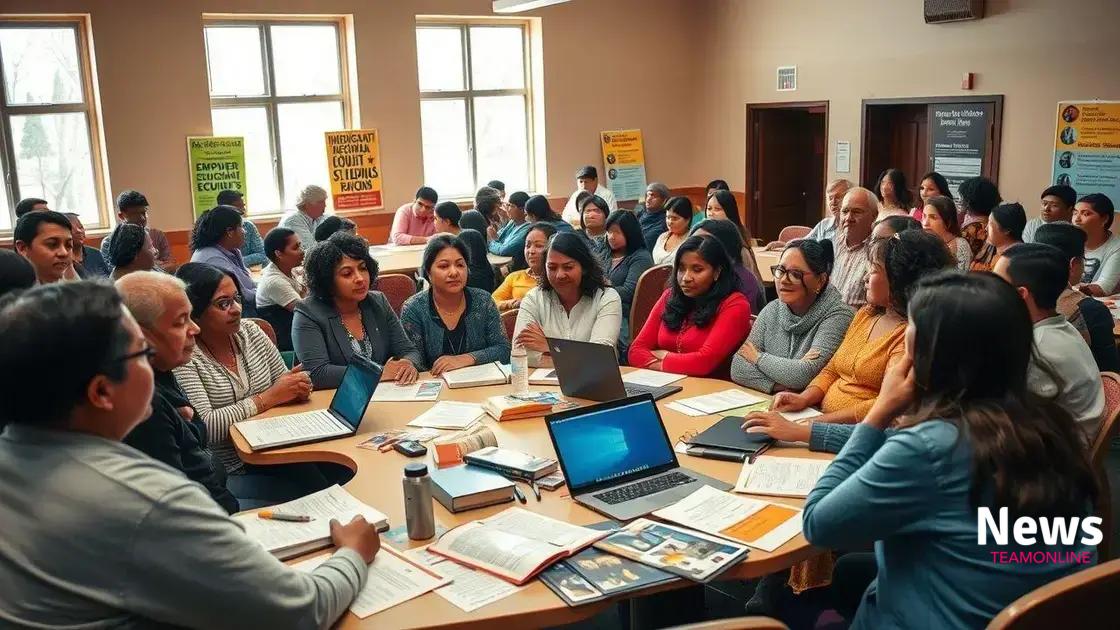Immigrant student rights legislation you should know

Immigrant student rights legislation ensures that all students, regardless of their immigration status, have access to quality education and protection from discrimination in schools.
Immigrant student rights legislation is vital for ensuring that all students have access to quality education. Many families may wonder how these laws specifically impact their children’s educational experiences. Let’s delve into this important topic.
Understanding immigrant student rights
Understanding immigrant student rights is essential for ensuring fair access to education. Many students may not be aware of the protections available to them. Each student deserves to learn in an environment that supports their growth.
What are immigrant student rights?
Immigrant student rights encompass a range of legal protections designed to ensure that all students, regardless of their immigration status, can receive an education. Schools cannot discriminate against students based on their immigration status.
Key points of immigrant student rights
- Every child has the right to attend school.
- Schools cannot ask about a student’s immigration status.
- Students are entitled to the same educational opportunities as their peers.
- Anti-discrimination laws protect students who may face bias.
These points are crucial in fostering a safe learning environment. It is vital for both students and families to understand their rights. Schools play a key role in ensuring that these rights are upheld. When students feel safe and supported, they can focus on their education.
Furthermore, many organizations and resources are available to assist immigrant families. These include legal aid services and community groups that provide information and support. Connecting with these resources can help families navigate challenges and advocate for their rights.
Being informed about immigrant student rights empowers students and their families. Awareness leads to stronger advocacy, ensuring that all students receive the quality education they deserve. Remember, understanding these rights is the first step toward a positive educational experience.
Key legislation affecting immigrant students
Key legislation affecting immigrant students shapes their educational experience significantly. Understanding these laws helps students and families navigate their rights in school settings. The most important laws aim to protect their access to education regardless of their immigration status.
Important laws to know
Several federal and state laws directly impact immigrant students. These include laws that ensure equitable access to educational resources and prohibit discrimination. It is crucial for families to be aware of these protections.
- Plyler v. Doe: This landmark Supreme Court case ensures that states cannot deny free public education to undocumented children.
- Every Student Succeeds Act (ESSA): This act outlines the rights of all students, including immigrant students, to receive a quality education.
- Title VI of the Civil Rights Act: This law prohibits discrimination based on national origin, protecting immigrant students from bias in schools.
- Deferred Action for Childhood Arrivals (DACA): While not directly related to education, DACA provides protections for some undocumented students, allowing them to pursue higher education.
These laws are designed to create a level playing field for all students. They promote the inclusion of immigrant students in public education systems. Schools across the country are required to adhere to these regulations, ensuring all students receive a fair chance to succeed.
Additionally, many local initiatives support these laws, aiming to create welcoming environments for immigrant families. Community organizations often provide resources that help families understand their rights and navigate the school system. Engaging with these resources can empower families to advocate effectively for their children.
Understanding the key legislation affecting immigrant students is essential for fostering a supportive educational experience. Families should continue to educate themselves on these matters, as knowledge is a powerful tool in advocating for educational rights.
How to advocate for immigrant student rights

Advocating for immigrant student rights is crucial for ensuring that these students receive the support they need. Being informed about their rights allows families and communities to take action. Advocacy can take many forms, from individual efforts to organized community initiatives.
Steps to advocate effectively
To advocate for immigrant student rights, individuals can take several practical steps. Awareness is the first step to effective advocacy, and understanding the rights of these students is essential.
- Educate yourself and others about the rights of immigrant students.
- Engage with local schools to discuss policies and practices that affect immigrant students.
- Attend community meetings to voice concerns and share experiences.
- Connect with local advocacy groups that focus on education and immigrant rights.
These actions can create a supportive network for parents and students. Another effective way to advocate is by using social media platforms. Sharing information online helps spread awareness and gather support from the broader community.
Additionally, organizing events that focus on the rights of immigrant students can help bring together families, educators, and community members. Workshops and informational sessions can equip families with tools and knowledge to navigate the education system. Collaborating with non-profit organizations can amplify advocacy efforts, as these groups often have resources and expertise to offer.
Being vocal about the challenges faced by immigrant students encourages others to join the advocacy movement. By creating a dialogue about the importance of education for all, individuals can help foster a more inclusive environment. The goal should always focus on ensuring equitable access to quality education for every student, regardless of their background.
Resources for immigrant students and families
Resources for immigrant students and their families play a vital role in supporting their educational journey. Access to information and assistance can significantly impact a student’s success. Families should know where to find help and what resources are available to them.
Types of resources available
There are numerous resources that cater specifically to the needs of immigrant students. Knowing how to leverage these can provide essential support during challenging times.
- Legal assistance: Organizations offer free or low-cost legal advice regarding immigration and education rights.
- Community organizations: Local groups often provide services like tutoring, mentorship, and family support.
- School resources: Many schools have staff dedicated to helping immigrant students understand their rights and available services.
- Online platforms: Websites and forums that discuss immigrant student rights and share resources are available for families looking to connect with others.
These resources serve as pillars of support for immigrant families. Moreover, connecting with local advocacy groups can empower families to navigate the education system more effectively. Workshops and community events are often organized by these groups to share vital information and promote resources.
Accessing educational materials in multiple languages is another key aspect. Many organizations provide translations of important documents and resources. This helps ensure that language barriers do not hinder access to education and support.
Staying informed about educational rights and available resources is crucial for families. Engaging with local communities can help build networks of support for immigrant students. The more informed families are, the better equipped they can be to advocate for their children’s education.
The future of immigrant student rights
The future of immigrant student rights is a topic of great importance as educational landscapes continue to evolve. As society changes, the need for inclusive policies that support all students persists. Understanding the trends and challenges ahead will help communities better prepare for the future.
Emerging trends in immigrant education
Several trends are emerging that impact immigrant students and their rights. These include increased awareness of educational inequalities and a push for more inclusive practices in schools.
- Policy changes: Many states are reconsidering their policies surrounding immigration and education, aiming to create more supportive environments for immigrant families.
- Cultural responsiveness: Schools are increasingly focusing on cultural awareness and sensitivity training for staff to better serve diverse student populations.
- Technology integration: Access to technology continues to grow, offering online resources that support language learning and educational attainment.
- Community engagement: Schools are fostering partnerships with local organizations to create strong support networks for immigrant students.
As these trends advance, advocacy for immigrant student rights becomes even more critical. Communities must work together to ensure that all students can thrive in an inclusive educational environment. Parents, educators, and advocates should remain vigilant in their efforts to highlight the importance of equal access to educational resources.
Another key aspect is the role of advocacy organizations. Many groups are focusing on protecting and expanding rights for immigrant students. These organizations often provide resources and training to families, empowering them to support their children effectively.
Ultimately, the future of immigrant student rights will depend on collective action and awareness. Educators and policymakers must collaborate to create policies that support all students, ensuring equity in education moving forward. As we look ahead, it is essential to remain committed to the principles of inclusion and support for every student.
In conclusion, advocating for the rights of immigrant students is vital to creating an inclusive and equitable educational environment. By understanding the laws, utilizing available resources, and collaborating with community organizations, families can significantly impact their children’s educational journey. As we move forward, it’s essential to remain proactive in addressing the challenges immigrant students face and to continue striving for policies that support their rights. Together, we can foster a future where every student has the opportunity to succeed, regardless of their background.
FAQ – Frequently Asked Questions about Immigrant Student Rights
What rights do immigrant students have in schools?
Immigrant students have the right to a free public education, regardless of their immigration status, and cannot be discriminated against in schools.
What resources are available for immigrant students and their families?
Many resources are available, including legal assistance, community organizations, and school programs designed to support immigrant families.
How can parents advocate for their children’s education rights?
Parents can advocate by educating themselves about their rights, attending school meetings, and connecting with local advocacy groups.
What is the future of immigrant student rights?
The future will depend on community advocacy, evolving policies that support inclusion, and continued focus on equitable education for all students.





